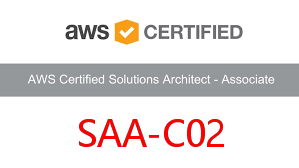AWS Certified Solutions Architect - Associate SAA-C02 Dumps
SAA-C02 is the new version code of AWS Certified Solutions Architect - Associate exam, the previous version SAA-C01 exam will be no longer to take after July 1, 2020. PassQuestion new released AWS Certified Solutions Architect - Associate SAA-C02 Dumps for your best preparation.You will feel confident to participate in SAA-C02 exam in your first attempt. PassQuestion 100% guarantee you to pass AWS Certified Solutions Architect - Associate SAA-C02 exam.

AWS Certified Solutions Architect - Associate SAA-C02 Exam Overview
The AWS Certified Solutions Architect - Associate examination is intended for individuals who perform a solutions architect role and have one or more years of hands-on experience designing available, cost-efficient, fault-tolerant, and scalable distributed systems on AWS.
A new version of the AWS Certified Solutions Architect - Associate exam (SAA-C02) will be available to take on and after March 23, 2020. The previous version of the AWS Certified Solutions Architect - Associate exam (SAA-C01) will also be available through July 1, 2020.
This new exam version (SAA-C02) includes updated content across all domains as well as new objectives aligned with AWS platform innovations in categories such as databases, cost optimization, and security. AWS Certification regularly updates this exam to reflect the rapid pace of innovation on the AWS platform and the latest in best practices for architecting on the AWS Cloud.
Candidates have the option to take the previous version (SAA-C01) through March 22, 2020 or the new version (SAA-C02) beginning on March 23, 2020.
AWS Certified Solutions Architect - Associate SAA-C02 Exam Details
Format: Multiple choice, multiple answer
Type: Associate
Delivery Method: Testing center or online proctored exam
Time: 130 minutes to complete the exam
Cost: 150 USD (Practice exam: 20 USD)
Language: Available in English, Japanese, Korean, and Simplified Chinese
SAA-C02 AWS Certified Solutions Architect - Associate Content Outline

Domain 1: Design Resilient Architectures
1.1 Design a multi-tier architecture solution
1.2 Design highly available and/or fault-tolerant architectures
1.3 Design decoupling mechanisms using AWS services
1.4 Choose appropriate resilient storage
Domain 2: Design High-Performing Architectures
2.1 Identify elastic and scalable compute solutions for a workload
2.2 Select high-performing and scalable storage solutions for a workload
2.3 Select high-performing networking solutions for a workload
2.4 Choose high-performing database solutions for a workload
Domain 3: Design Secure Applications and Architectures
3.1 Design secure access to AWS resources
3.2 Design secure application tiers
3.3 Select appropriate data security options
Domain 4: Design Cost-Optimized Architectures
4.1 Identify cost-effective storage solutions
4.2 Identify cost-effective compute and database services
4.3 Design cost-optimized network architectures

View Online AWS Certified Solutions Architect - Associate SAA-C02 Free Questions
1.A solutions architect is designing a solution where users will be directed to a backup static error page if the primary website is unavailable. The primary website’s DNS records are hosted in Amazon Route 53 where their domain is pointing to an Application Load Balancer (ALB).
Which configuration should the solutions architect use to meet the company’s needs while minimizing changes and infrastructure overhead?
A. Point a Route 53 alias record to an Amazon CloudFront distribution with the ALB as one of its origins. Then, create custom error pages for the distribution.
B. Set up a Route 53 active-passive failover configuration. Direct traffic to a static error page hosted within an Amazon S3 bucket when Route 53 health checks determine that the ALB endpoint is unhealthy.
C. Update the Route 53 record to use a latency-based routing policy. Add the backup static error page hosted within an Amazon S3 bucket to the record so the traffic is sent to the most responsive endpoints.
D. Set up a Route 53 active-active configuration with the ALB and an Amazon EC2 instance hosting a static error page as endpoints. Route 53 will only send requests to the instance if the heal checks fail for the ALB.
Answer: B
2.A solutions architect is designing a high performance computing (HPC) workload on Amazon EC2. The EC2 instances need to communicate to each other frequently and require network performance with low latency and high throughput.
Which EC2 configuration meets these requirements?
A. Launch the EC2 instances in a cluster placement group in one Availability Zone.
B. Launch the EC2 instances in a spread placement group in one Availability Zone.
C. Launch the EC2 instances in an Auto Scaling group in two Regions and peer the VPCs.
D. Launch the EC2 instances in an Auto Scaling group spanning multiple Availability Zones.
Answer: A
3.A company wants to host a scalable web application on AWS. The application will be accessed by users from different geographic regions of the world. Application users will be able to download and upload unique data up to gigabytes in size. The development team wants a cost-effective solution to minimize upload and download latency and maximize performance.
What should a solutions architect do to accomplish this?
A. Use Amazon S3 with Transfer Acceleration to host the application.
B. Use Amazon S3 with CacheControl headers to host the application.
C. Use Amazon EC2 with Auto Scaling and Amazon CloudFront to host the application.
D. Use Amazon EC2 with Auto Scaling and Amazon ElastiCache to host the application.
Answer: C
4.A company is migrating from an on-premises infrastructure to the AWS Cloud. One of the company’s applications stores files on a Windows file server farm that uses Distributed File System Replication (DFSR) to keep data in sync. A solutions architect needs to replace the file server farm.
Which service should the solutions architect use?
A. Amazon EFS
B. Amazon FSx
C. Amazon S3
D. AWS Storage Gateway
Answer: B
5.A company has a legacy application that process data in two parts. The second part of the process takes longer than the first, so the company has decided to rewrite the application as two microservices running on Amazon ECS that can scale independently.
How should a solutions architect integrate the microservices?
A. Implement code in microservice 1 to send data to an Amazon S3 bucket. Use S3 event notifications to invoke microservice 2.
B. Implement code in microservice 1 to publish data to an Amazon SNS topic. Implement code in microservice 2 to subscribe to this topic.
C. Implement code in microservice 1 to send data to Amazon Kinesis Data Firehose. Implement code in microservice 2 to read from Kinesis Data Firehose.
D. Implement code in microservice 1 to send data to an Amazon SQS queue. Implement code in microservice 2 to process messages from the queue.
Answer: D
6.A company captures clickstream data from multiple websites and analyzes it using batch processing. The data is loaded nightly into Amazon Redshift and is consumed by business analysts. The company wants to move towards near-real-time data processing for timely insights. The solution should process the streaming data with minimal effort and operational overhead.
Which combination of AWS services are MOST cost-effective for this solution? (Choose two.)
A. Amazon EC2
B. AWS Lambda
C. Amazon Kinesis Data Streams
D. Amazon Kinesis Data Firehose
E. Amazon Kinesis Data Analytics
Answer: AD
- TOP 50 Exam Questions
-
Exam
All copyrights reserved 2025 PassQuestion NETWORK CO.,LIMITED. All Rights Reserved.

